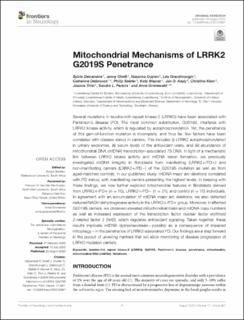| dc.contributor.author | Delcambre, Sylvie | |
| dc.contributor.author | Ghelfi, Jenny | |
| dc.contributor.author | Ouzren, Nazzima | |
| dc.contributor.author | Grandmougin, Lea | |
| dc.contributor.author | Delbrouck, Catherine | |
| dc.contributor.author | Seibler, Philip | |
| dc.contributor.author | Wasner, Kobi | |
| dc.contributor.author | Aasly, Jan | |
| dc.contributor.author | Klein, Christine | |
| dc.contributor.author | Trinh, Joanne | |
| dc.contributor.author | Pereira, Sandro L | |
| dc.contributor.author | Grünewald, Anne | |
| dc.date.accessioned | 2021-05-10T10:12:05Z | |
| dc.date.available | 2021-05-10T10:12:05Z | |
| dc.date.created | 2021-02-22T22:17:09Z | |
| dc.date.issued | 2020 | |
| dc.identifier.citation | Frontiers in Neurology. 2020, 11, . | en_US |
| dc.identifier.issn | 1664-2295 | |
| dc.identifier.uri | https://hdl.handle.net/11250/2754595 | |
| dc.description.abstract | Several mutations in leucine-rich repeat kinase-2 (LRRK2) have been associated with Parkinson's disease (PD). The most common substitution, G2019S, interferes with LRRK2 kinase activity, which is regulated by autophosphorylation. Yet, the penetrance of this gain-of-function mutation is incomplete, and thus far, few factors have been correlated with disease status in carriers. This includes (i) LRRK2 autophosphorylation in urinary exosomes, (ii) serum levels of the antioxidant urate, and (iii) abundance of mitochondrial DNA (mtDNA) transcription-associated 7S DNA. In light of a mechanistic link between LRRK2 kinase activity and mtDNA lesion formation, we previously investigated mtDNA integrity in fibroblasts from manifesting (LRRK2+/PD+) and non-manifesting carriers (LRRK2+/PD-) of the G2019S mutation as well as from aged-matched controls. In our published study, mtDNA major arc deletions correlated with PD status, with manifesting carriers presenting the highest levels. In keeping with these findings, we now further explored mitochondrial features in fibroblasts derived from LRRK2+/PD+ (n = 10), LRRK2+/PD- (n = 21), and control (n = 10) individuals. In agreement with an accumulation of mtDNA major arc deletions, we also detected reduced NADH dehydrogenase activity in the LRRK2+/PD+ group. Moreover, in affected G2019S carriers, we observed elevated mitochondrial mass and mtDNA copy numbers as well as increased expression of the transcription factor nuclear factor erythroid 2-related factor 2 (Nrf2), which regulates antioxidant signaling. Taken together, these results implicate mtDNA dyshomeostasis-possibly as a consequence of impaired mitophagy-in the penetrance of LRRK2-associated PD. Our findings are a step forward in the pursuit of unveiling markers that will allow monitoring of disease progression of LRRK2 mutation carriers. | en_US |
| dc.language.iso | eng | en_US |
| dc.publisher | Frontiers Media | en_US |
| dc.rights | Navngivelse 4.0 Internasjonal | * |
| dc.rights.uri | http://creativecommons.org/licenses/by/4.0/deed.no | * |
| dc.title | Mitochondrial Mechanisms of LRRK2 G2019S Penetrance | en_US |
| dc.type | Peer reviewed | en_US |
| dc.type | Journal article | en_US |
| dc.description.version | publishedVersion | en_US |
| dc.source.volume | 11 | en_US |
| dc.source.journal | Frontiers in Neurology | en_US |
| dc.identifier.doi | 10.3389/fneur.2020.00881 | |
| dc.identifier.cristin | 1892569 | |
| dc.description.localcode | Copyright © 2020 Delcambre, Ghelfi, Ouzren, Grandmougin, Delbrouck, Seibler, Wasner, Aasly, Klein, Trinh, Pereira and Grünewald. This is an open-access article distributed under the terms of the Creative Commons Attribution License (CC BY). The use, distribution or reproduction in other forums is permitted, provided the original author(s) and the copyright owner(s) are credited and that the original publication in this journal is cited, in accordance with accepted academic practice. No use, distribution or reproduction is permitted which does not comply with these terms. | en_US |
| dc.source.articlenumber | 881 | en_US |
| cristin.ispublished | true | |
| cristin.fulltext | original | |
| cristin.qualitycode | 1 | |

